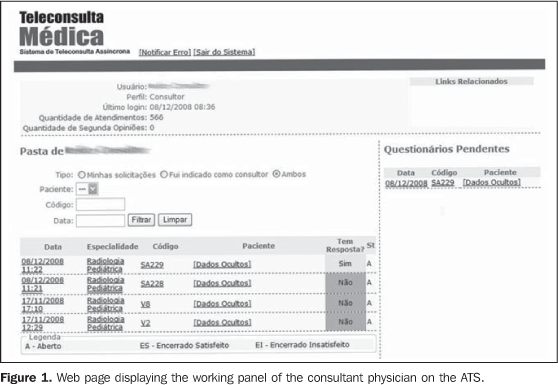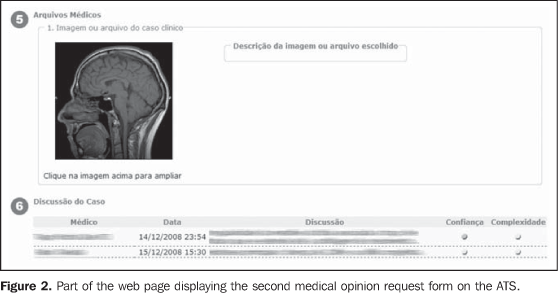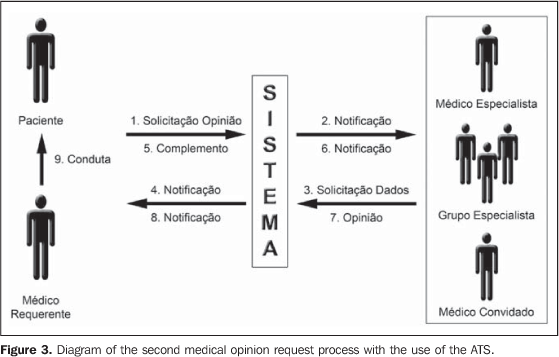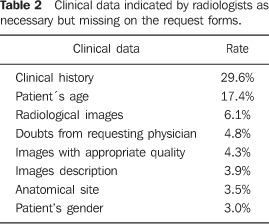Radiologia Brasileira - Publicação Científica Oficial do Colégio Brasileiro de Radiologia
AMB - Associação Médica Brasileira CNA - Comissão Nacional de Acreditação
 Vol. 43 nº 3 - May / June of 2010
Vol. 43 nº 3 - May / June of 2010
|
ORIGINAL ARTICLE
|
|
Evaluation of a second opinion system in radiology |
|
|
Autho(rs): Ricardo Alfredo Quintano Neira, Andrea Puchnick, Frederico Molina Cohrs, Paulo Roberto de Lima Lopes, Henrique Manoel Lederman, Ivan Torres Pisa |
|
|
Keywords: Telemedicine, Remote consultation, Referral and consultation, Radiology, Imaging diagnosis |
|
|
Abstract:
IMaster of IT in Health, Architect in Health at Zilics Sistemas de Informação em Saúde, São Paulo, SP, Brazil
INTRODUCTION The exchange of clinical information among healthcare professionals may provide improved clinical effectiveness, better assistance quality and cost reduction. Telemedicine has been utilized as a relevant tool in this context(1). One of the ways to practice telemedicine is to seek a second medical opinion, which consists of searching for advices and medical information from a remotely located professional. The second opinion may be of assistance in the process of investigation on a patient´s health problem and in the definition of the therapeutic approach. In radiology, the use of a second opinion system involves the need of evaluating medical images, and for that reason, one must assure that the images utilized in the second opinion process present an appropriate quality(2,3). In Brazil, experiments with remote second medical opinion have been reported, as in the case of Hospital Sírio-Libanês, which has developed a joint project with the Memorial Sloan-Kettering Cancer Center from New York and BH-Telessaúde, with telemedicine activities in the areas of medicine, nursing and odontology(4,5). The present study is aimed at describing a second medical opinion process by means of the use of a web-based multi-specialty system adapted for radiology.
MATERIALS AND METHODS In the present study, the requesting physician is defined as the one who asks for the second medical opinion while the physician providing the second opinion is the radiologist. Normally, the requesting physician is the one who is directly providing assistance to the patient. A system for second medical opinion named Asynchronous Telemedicine System (ATS)(6) was developed at the Information Technology on Health Department (ITHD) of Universidade Federal de São Paulo (Unifesp). The web-based ATS was built with open software technologies (Java language, MySQL database) and is available at http://telemedicina6.unifesp.br:8080/sta. The system allows the requesting physician to post his doubts and medical files, such as images and clinical data on the patient to radiologists, in order to obtain a second opinion. The responses received from the radiologists may help the requesting physician in the investigation of the problem as well as in the definition of the therapeutic approach for that particular patient. Figures 1 and 2 show the interface screens of the ATS.
The system presents the following functionalities: remote request for a second opinion; confidentiality on patient's data; attachment of medical files in the DOC, PDF, JPEG, TIFF and DICOM formats; conversion of DICOM and TIFF image files into JPEG format in order to facilitate the images visualization with any web browser without the need to install special softwares; discussion of the clinical case with all participating physicians; and storage and user friendly search for all the previously requested remote second opinions. Each medical specialty requires a baseline and exclusive set of information for a remote consultation. For example, dermatology will probably require information on skin tone, photographs, etc., while radiography requires digital images and description of the patient's clinical status. Thus ATS was created to support multiple specialties, allowing the customization of second opinion request forms in accordance with the needs of each specialty, without the need to resource to costly implementations. An experiment with the ATS was developed between November and December of 2008, to evaluate a remote second opinion process in radiology. Such process was developed by the researchers, and validated by a specialist in radiology of the Department of Imaging Diagnosis (DID) and adjusted to the ATS. The evaluation was performed in two groups. The first group comprised of radiologists, and the second group comprised of residents. The evaluation of the first group did not generate valid results, due to the lack of interest of the physicians. The second group had the participation of 49 residents of the DID, that played the role of radiologists. The participants' ages ranged from 24 to 30 years, and 19 were in their first year of residency, 15 were in the second year of residency, 14 were in their third year and one was in the fourth year of residence. Fifty-two second opinion requests for cases selected by a DID radiologist were posted. All the posts presented the description of the clinical status, with only one mentioning the patient´s gender, and 3 mentioning the patients' ages. Questionnaires were utilized as an evaluation tool, covering information on the previous knowledge on the system, on the request, users' opinion and satisfaction with the system, as well as analysis of data generated by the use of the system. The defined process for second opinion request utilizes an appropriate form for the radiology specialty. Figure 3 demonstrates the process of second medical opinion request utilizing the developed system. The requesting physician may request a second opinion in case of doubt on the diagnosis for his/her patient. For this purpose, the physician fills out the request form in the system, providing data on the patient, consultation information and reason for the request (step 1). Then, the system notifies the radiologist that a new request for a medical opinion has been entered (step 2). The radiologist evaluates the request, verifying whether it comprises all the relevant data in order to provide his opinion. Whenever necessary, the radiologist may contact the requesting physician by means of the system, to ask for additional data on the case in order to complement the request (steps 3, 4, 5 and 6). With all the necessary information available, the radiologist issues his opinion through the system to the requesting physician (step 7). The system notifies the requesting physician that the request has a new opinion (step 8). Finally, the requesting physician indicates the recommended approach for that particular patient (step 9).
The success of a second medical opinion depends upon the accuracy of the relevant information provided by the requesting physician to the radiologist(7). This is facilitated by the questionnaires developed by the radiologist that indicate which information is essential for the diagnosis. In the present study, the term "request form" was utilized to represent such questionnaires. Table 1 presents the details of the attributes comprising the request form. Patient´s demographic data were based on the ISO Provider Identification(8) standard.
RESULTS All the second opinions issued by the physicians participating in the experiment were categorized by a radiologist. The following criteria were adopted for the analysis: the responses from physicians that answered to less than half of the second opinion requests (26 requests) were not categorized; responses from physicians not belonging to Unifesp (total of six physicians) were not categorized; the responses were categorized as satisfactory or unsatisfactory; the response was categorized as satisfactory when it presented an appropriate diagnosis for the case described in the request; if the response did not present a medical opinion, it was categorized as unsatisfactory. A total of 1,704 responses given by 34 physicians were evaluated. Of this total, 514 (29.1%) responses were defined as satisfactory. With regards to the complexity of each request, the physicians informed on whether the requests were simple or complex. Of the 1,704 responses, 630 (37.5%) indicated that the responding physician considered the request as simple, while 953 (55.9%) were considered as complex. In 112 responses there were no comments regarding this topic. The physicians participating in the experiment also informed the level of certainty on their opinions, by informing "certainty < 75%" or "certainty > 75%"on their diagnosis. Of the 1,704 responses, 703 (43.0%) indicated that the responding physicians indicated "certainty > 75%" on their diagnosis, 864 (50.7%) indicated "certainty < 75%", and 107 (6.3%) did not respond to this topic. The response time to issue a medical second opinion corresponds to the time required by the radiologist to read, analyze, study and issue the second opinion. For the definition of such time, the adopted criterion was that of the physician issuing his opinion while logged in the system, thus being able to observe data on the requests and medical images in detail. Thus, the total access time for all the physicians on the system was considered (202 hours and 54 minutes, corresponding to approximately eight days) and divided by the total number of responses with a second opinion (n = 1,891). The mean response time was six minutes and 26 seconds. Such time is close to the time spent in the generation of traditional reports based on paper, which is six minutes and 48 seconds(9). With respect to radiological images, a comparison between images presented on the second medical opinion requests on the ATS and radiological images that a radiologist observes on his daily activities, 65% of the responses to the questionnaires indicate that there is a loss in quality of the radiological images, although 64.4% indicated that the quality did not compromise the diagnosis. It is important to note the fact that all the second medical opinion requests presented only JPEG and TIFF image files, and that in accordance with the Resolution No. 1890 dated of January 15, 2009, of Conselho Federal de Medicina (Federal Council of Medicine)(10), the transmission of radiological images must be performed with JPEG images files with a minimum resolution of 4 megapixels or DICOM image files (varying according to the level of the image study performed). Among the responses, 38.2% indicated the need to add further resources such as magnification (zoom), brightness and contrast settings to the ATS to aid in the analysis of images. The evaluation on user satisfaction with the system indicated that the ATS is easy to use (mean grade = 87.8%) and to be assimilated for use (mean grade = 95.6%). Some improvements were suggested, for example, reinforcing the indications to the user on how the system is operating, make the error messages more clear and direct, and design screens that take the user experience level into consideration. During the experiment, one of the difficulties observed was the capture of images from the radiological system and their entry into the ATS. The image files should be exported to a temporary folder prior to be entered into the ATS. This also occurred with the patient's data and consultation information, which had to be copied from the electronic records. A lot of difficulty was observed with the physicians in this process. It was also observed that the residents failed to complete the step in the request process in which the radiologist asks the requesting physician to complement the information on the clinical case. Some requests presented insufficient data to support an opinion, and even so the radiologists provided their second opinion. In the questionnaires, the physicians indicated the missing data on the requests, which were most critical for the second opinion elaboration. Table 2 shows such results.
DISCUSSION The success of a medical second opinion depends upon the remittance of relevant data from the requesting physician to the radiologist(7). The use of second opinion request forms may minimize the problem of incomplete or unnecessary data forwarding to the radiologist and, as a consequence, may speed up the request response time. By analyzing the radiologists' responses, one observed the use of terms with multiple meanings that are strongly dependent on the context, for example the word "history", which might mean the history of the current disease, previous disease history, family history or clinical history. In telemedicine, the utilization of ambiguous or appropriate terms may negatively affect the text interpretation(11), when one considers that the involved physicians had different education and experiences and thus may ignore the meanings intended by the colleagues. Based on such results, it is suggested that the quality committees or councils standardize the terminology utilized in the remote collaboration based on current nomenclature systems, such as the International Classification of Diseases (ICD), the Systematized Nomenclature of Medicine (SNOMED) and the Logical Observation Identifiers Names and Codes (LOINC). The cost of developing telemedicine systems, as with any other system in the field of health, is usually high as such systems comprise clinical knowledge, data security, interoperability with other systems and implementation costs. It is believed that in the medium/long term the investment will return with the reduction of other costs, such as costs of health staff and patients transportation. The continued utilization of digital telemedicine systems for a second medical opinion will have greater chances of being adopted with the implementation of inter-operability between health systems. Thus, the health professional will not need to manually copy clinical data from one system to another. In order to facilitate such process, it will be necessary to develop standardized communication protocols between systems. A suggestion for such protocol is the Clinical Document Architecture (CDA) R2(12) of HL7 v3(13) standard that is currently utilized by Secretaria Municipal de Saúde de São Paulo (SMS-SP) (Municipal Health Department of the City of São Paulo) to automate the process of the Serviço Auxiliar de Diagnóstico e Terapia (SADT) (Auxiliary Services for Diagnosis and Therapy)(14). The HL7-CDA is an electronic documentation standard that specifies the structure and semantics of clinical documents for the purpose of data transfer. The system model utilized in the present study allows digital medical communities to be created. Thus, the health assistance of specialized physicians can be extended from reference centers to underserved communities. Such digital communities may be public, in such a manner that physicians provide pro-bono collaboration, similarly to Orkut, Facebook, Twitter(15-17), or private. As a prospect for research in the area, it is important to define an organizational process for the utilization of second opinion systems. The system and the process must be studied on a "running system basis" to evaluate its practicity and usefulness.
CONCLUSION The second medical opinion process by means of a web-based multispecialty system adapted for radiology may be an excellent tool in the management of clinical and therapeutic approaches. However, it is important to establish a well defined work-flow with the cooperation of all involved professionals. The success of a second medical opinion depends on the transference of relevant and complete data.
REFERENCES 1. Nobre LF, von Wangenheim A, Maia RS, et al. Certificação digital de exames em telerradiologia: um alerta necessário. Radiol Bras. 2007;40:415-21. [ ] 2. Della Mea V. Prerecorded telemedicine. In: Wootton R, Craig J, Patterson V, editors. Introduction to telemedicine. London, UK: The Royal Society of Medicine Press Ltd; 2006. p. 37-50. [ ] 3. Lima CMAO, Monteiro AMV, Ribeiro EB, et al. Videoconferências. Sistematização e experiências em telemedicina. Radiol Bras. 2007;40:341-4. [ ] 4. Neira RAQ, Zavitoski LG, Lopes PRL, et al. Brazilian telemedicine networks. In: Proceedings of the First International Conference on Health Informatics, HEALTHINF. 2008;1:235-8. Funchal, Madeira, Portugal, January 28-31, 2008. [ ] 5. Santos AF, Souza C, Alves HJ, et al. Telessaúde - um instrumento de suporte assistencial e educação permanente. Belo Horizonte, MG: Editora UFMG; 2007. [ ] 6. Neira RAQ. Construção e avaliação de sistema de segunda opinião médica em radiologia [dissertação de mestrado]. São Paulo: Universidade Federal de São Paulo; 2009. [ ] 7. Ferguson J. How to do a telemedicine consultation. In: Wootton R, Craig J, Patterson V, editors. Introduction to telemedicine. London, UK: The Royal Society of Medicine Press Ltd; 2006. p. 119-31. [ ] 8. International Organization for Standardization (ISO). ISO/TS 22220:2009, Health informatics - identification of subjects of health care. Geneva, Switzerland; 2009. [acessado em 15 de novembro de 2009]. Disponível em: http://www.iso.org/iso/catalogue_detail.htm?csnumber=40782 [ ] 9. Ferreira DM. Comparação dos tempos de geração e digitação de laudos radiológicos entre um sistema eletrônico baseado em voz sobre IP (VOIP) e um sistema tradicional baseado em papel [dissertação de mestrado]. São Paulo: Universidade Federal de São Paulo; 2009. [ ] 10. Conselho Federal de Medicina. Resolução CFM nº 1.890. [acessado em 15 de novembro de 2009]. Disponível em: http://www.cremesp.org.br/library/modulos/legislacao/versao_impressao.php?id=8126 [ ] 11. Bacelar S, Galvão CC, Alves E, et al. Expressões médicas: falhas e acertos. Rev Bras Cir Cardiovasc. 2003;18:iii-xii. [ ] 12. Dolin RH, Alschuler L, Boyer S, et al. HL7 Clinical Document Architecture, Release 2.0. [acessado em 15 de novembro de 2009]. Disponível em: http://healthinfo.med.dal.ca/hl7intro/ CDA_R2_NormativeWebEdition/infrastructure/cda/cda.htm [ ] 13. HL7 Version 3. Miami, FL, EUA: Health Level Seven, Inc; 2007. [acessado em 15 de novembro de 2009]. Disponível em: http://www.hl7.org/v3ballot/html/welcome/environment/ [ ] 14. Cuellas ACMM, Neira RAQ, Leão BF, et al. Integração de sistemas laboratoriais na SMS-SP. In: XI Congresso Brasileiro de Informática em Saúde, 2008. [acessado em 15 de novembro de 2009]. Disponível em: http://www.sbis.org.br/cbis11/arquivos/1028.pdf [ ] 15. Orkut, 2004. [acessado em 7 de fevereiro de 2010]. Disponível em: http://www.orkut.com.br/ [ ] 16. Facebook, 2004. [acessado em 7 de fevereiro de 2010]. Disponível em: http://www.facebook.com [ ] 17. Twitter, 2006. [acessado em 7 de fevereiro de 2010]. Disponível em: http://www.twitter.com [ ]
Received November 19, 2009.
* Study developed at Universidade Federal de São Paulo (Unifesp), São Paulo, SP, Brazil. |
|
Av. Paulista, 37 - 7° andar - Conj. 71 - CEP 01311-902 - São Paulo - SP - Brazil - Phone: (11) 3372-4544 - Fax: (11) 3372-4554




